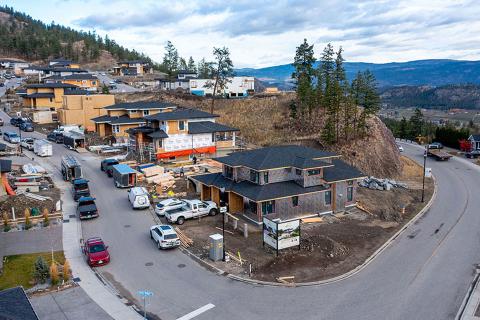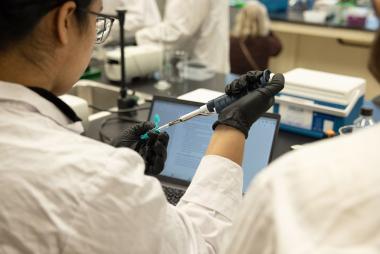UBC Okanagan Engineering leads research to explore new net zero home

This article originally appeared on UBC Okanagan News.
A unique, made-in-Kelowna collaboration to create an energy-efficient, high-performance home is taking the goal to the next level. And that goal is zero.
UBC Okanagan, Okanagan College, the Wilden Group, AuthenTech Homes and FortisBC launched the Wilden Living Lab project in 2016 when two homes were constructed side by side in the Wilden community. One is called the Home of Today and was built to regular specifications and codes. The other, called the Home of Tomorrow, was constructed with advanced materials and systems that made it an energy-efficient home.
While the homes were built by AuthenTech Homes and the Wilden Group, with help from Okanagan College trades students, UBC Okanagan Professor Dr. Shahria Alam and his team conducted research to compare the energy use and costs of the two buildings once occupied. An extensive monitoring system consisting of temperature, humidity and power sensors, was utilized to collect, analyze and compare energy and cost variations in the two homes. After the initial three years, the comparative results show that the Home of Tomorrow used 67 per cent less energy and had 99.6 per cent fewer carbon emissions than its neighbour.
“Sustainable energy usage and homebuilding practices are important issues for our community,” said Dr. Alam. “UBC Okanagan is pleased to lend its research expertise to a project that will encourage sustainable development here at home and provide tools for others around the world to follow in our footsteps.”
Now, the collaboration is going further with the construction of a third next-generation home, built to the BC Energy Step Code’s highest level, Step 5. The house—with a high-tech building envelope that is airtight and is complete with an efficient solar photovoltaic system, top-notch energy recovery and storage systems and highly efficient mechanical systems—will achieve net zero energy, meaning it will produce as much, or more energy than it uses in a year.
The provincial government is requiring that by 2032 all new buildings will be constructed to Step 5 conditions. With only a few years to go, there is a major push to educate construction practitioners about the BC Energy Step Code, says Dr. Alam, who teaches in UBCO's School of Engineering.
With this new code, the building industry must follow tactics to reduce the total energy requirements of new buildings, Dr. Alam explained. This is done by creating high insulation wall systems and airtight envelopes, installation of highly energy-efficient windows and mechanical systems, use of heat energy recovery systems and renewable energy systems.
However, with the exception of the appliances, the elements of a high-performance home are often invisible to the homebuyer, said Dr. Andrew Hay, Provost and Vice President Academic for Okanagan College.
“The Wilden Living Lab is a superb initiative that can help move us forward to understanding the best approaches for energy-efficient residential construction projects that considers conservation from a wide perspective,” said Dr. Hay. “By assessing how better buildings can function in the real world, we will continue to learn and adapt new design parameters. In time, with this information in the hands of those designing, constructing and purchasing new homes, we hope to continue to demonstrate the best of BC approaches to residential construction and create momentum in the industry for green construction at its best.”
That’s why the public is being encouraged to explore the home, which will be open for daily tours, complete with interactive displays, for the next six months.
“We’re excited to open this house to the community. We want people to come and walk through the home and experience the difference of a net zero house,” said Karin Eger-Blenk, CEO of the Wilden Group. “For us, the Wilden Living Lab is a place where we can make homeowners familiar with future-proof building practices and have new technologies tested out for them. The goal is to encourage everyone who’s building a home in Wilden or elsewhere to invest in energy efficiency.”
The project is a clear example of how industry and post-secondary schools can work together to make a difference for the future, says Carol Suhan, Manager, Community Programs, Conservation and Energy Management at FortisBC. The project combines academic research, experiential learning for trades and contractor training students, ongoing energy monitoring and the creation of an electronic contractor decision support tool led by UBCO.
“This project brings energy efficiency to life and is a great opportunity for the industry to demonstrate what a Step 5 and net zero home is all about,” said Suhan. “We want to invite the community to come to the home to see, touch, feel and hear the benefits of the materials and techniques that contribute to a Step 5 home. This is a great opportunity for people to learn how energy-efficient construction saves energy and reduces greenhouse gas emissions. It will help our customers make informed decisions when it comes to their home’s energy use, comfort and long-term affordability.”
Phase 2 of the Wilden Living Lab project is open to the public starting Sunday, November 20, at noon. The home will remain open to the public to explore weekly, Saturday through Thursday, noon to 5 pm until May 18, 2023.


